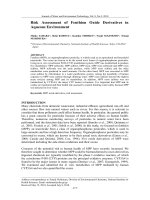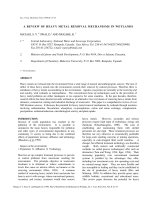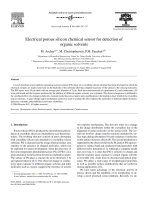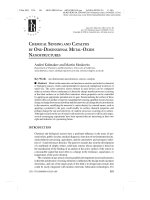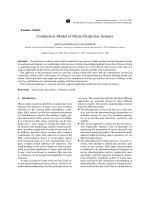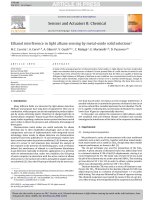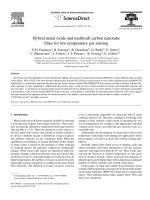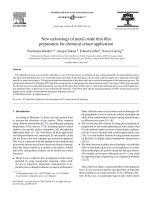metal oxide nanoparticles in organic solvents
Bạn đang xem bản rút gọn của tài liệu. Xem và tải ngay bản đầy đủ của tài liệu tại đây (4.1 MB, 230 trang )
Engineering Materials and Processes
Series Editor
Professor Brian Derby, Professor of Materials Science
Manchester Materials Science Centre, Grosvenor Street, Manchester, M1 7HS, UK
Other titles published in this series
Fusion Bonding of Polymer Composites
C. Ageorges and L. Ye
Composite Materials
D.D.L. Chung
Titanium
G. Lütjering and J.C. Williams
Corrosion of Metals
H. Kaesche
Corrosion and Protection
E. Bardal
Intelligent Macromolecules for Smart Devices
L. Dai
Microstructure of Steels and Cast Irons
M. Durand-Charre
Phase Diagrams and Heterogeneous Equilibria
B. Predel, M . Hoch and M. Pool
Computational Mechanics of Composite
Materials
M. Kami
´
nski
Gallium Nitride Processing for Electronics,
Sensors and Spintr onics
S.J. Pearton, C.R. Abernathy and F. Ren
Materials for Information Technology
E. Zschech, C. Whelan and T. Mikolajick
Fuel Cell Technology
N. Sammes
Casting: An Analytical Approach
A. Reikher and M.R. Barkhudarov
Computational Quantum Mechanics for
Materials Engineers
L. Vitos
Modelling of Powder Die Compaction
P.R. Brewin, O. Coube, P. Doremus
and J.H. Tweed
Silver Metallization
D. Adams, T.L. Alford and J.W. Mayer
Microbiologically Influenced Corrosion
R. Javaherdashti
Modeling of Metal Forming and Machining
Processes
P.M. Dixit and U.S. Dixit
Electromechanical Properties in Composites
Based on Ferroelectrics
V.Yu. Topol ov and C.R. Bowen
Charged Semiconductor Defects
E.G. Seebauer and M.C. Kratzer
Modelling Stochastic Fibrous Materials
with Mathematica
®
W.W. Sampson
Ferroel ectrics in Microwave Devices,
Circuits and Syst ems
S. Gevorgian
Markus Niederberger
•
Nicola Pinna
Metal Oxide Nanoparticles
in Organic Solvents
Synthesis, Formation, Assembly
and Application
123
Prof. Dr. Markus Niederberger
Swiss Federal Institute of Technology
(ETH) Zurich
Department of Materials
Laboratory for Multifunctional Materials
Wolfgang-Pauli-Strasse 10
8093 Zurich
Switzerland
Prof. D r. Nicola Pinna
University of Aveiro
Department of Chemistry, CICECO
Campus Universitario de Santiago
3810-193 Aveiro
Portugal
and
Seoul National University (SNU)
College of Engineering
School of Chemical
and Biological Engineering
151-744 Seoul
Korea
ISSN 1619-0181
ISBN 978- 1-84882-670-0
DOI 10.1007/978-1-84882-671-7
e-ISBN 978-1-84882-671-7
Springer Dordrecht Heidelberg London New York
British Library Cataloguing in Publication Data
A catalogue record for this book is available from the British Library
Library of Congress Control Number: 2009931370
© Springer-Verlag London Limited 2009
Apart from any fair dealing for the purposes of research or priv ate study, or criticism or review, as
permitted under the Copyright, Designs and Patents Act 1988, this publication may only be reproduced,
stored or transmitted, in any form or by any means, with the prior permission in writing of t he publishers,
or in the case of reprographic reproduction in accordance with the t erms of licences issued by the
Copyright Licensing Agency. Enquiries concerning reproduction outside those terms should be s ent to
the publishers.
The use of registered names, trademarks, etc. in this publication does not imply, even in the absence of a
specific s t atement, that such names are exempt from the relev ant laws and regulations and therefore free
for general use.
The publisher makes no r epresentation, express or implied, with regard to the accuracy of the information
contained in this book and cannot accept any legal responsibility or liability for any errors or omissions
that may be made.
Cover design: eStudioCalamar, Figueres/Berlin
Printed on acid-free paper
Springer is part of Springer Science+Business Media (www.springer.com)
To our wives Anja and Sabina
“This page left intentionally blank.”
Foreword
Some scientists, especially those far off materials sciences, still perceive the
prefix “nano” as a hype. To my opinion, this notation might describe the
vigorous expansion phase of nanosciences and nanotechnology, but the hype
meanwhile turned into real science, into real products and jobs.
Contrary to previous hyped topics, the nano-community was able to fill
many promises with reality, at least to a larger extent, and this is why
nanosciences are still flourishing, still growing, partly even beyond expec-
tations of the educated experts.
A key part of nanosciences is nanoparticulate matter, including nanoparti-
cles, nanorods, nanoplates, or even more complex tectonic assemblies. Exactly
on these examples we can nicely illustrate what nanosciences really provides.
Simply by finely dispersing common bulk materials down to the nanoscale,
new properties can be observed: inert materials become catalysts, insulators
become conductors, white substances become transparent, stable materials
become combustible. It is known since the ancient world: Gold nanoparticles
are shining red or blue, and the beauty of medieval church windows is based
on the extraordinary color strength and the high thermal stability of those
dispersions, exceeding ordinary dyes by some orders of magnitude.
There is more than only plasmonic color to be discovered: There is a whole
new world out there in the nano cosmos, a world which already Wolfgang
Ostwald about a hundred years ago named the “world of lost dimension”.
Some colleagues even regard nanostructures as a new adjustable state of
matter. This is due to the fact that atoms at surfaces behave differently to
those in the bulk, and nanoparticles are literally dominated by those surfaces.
It is a save prediction: The new questions to face while analyzing alterna-
tive energy cycles of society, communication technology, the desire for new
catalysts for more efficient chemical reactions, new light sources, or better
performing construction materials will only be answered by implementation
of nanostructural aspects. There will be no real alternative or choice.
For many of those applications, appropriate nanostructures however do not
yet exist, or their production is not sustainable so that “de novo”systems and
vii
viii Foreword
their synthetic pathways have to be designed from scratch. This is where the
present book sets in: Both authors are most competent in this field, pioneers
of a synthetic route towards metal oxide nanoparticles, which is meanwhile
called “nonaqueous sol-gel route”. This technique not only turned out to be
simple, convenient, scalable, mass efficient and rather sustainable, but it also
was proven to be extremely flexible with respect to size and composition so
that – within just a few years – an impressive number of binary, ternary and
quaternary nanocrystalline oxides in a variety of sizes and morphologies could
be assessed. This explosive development is nicely summarized and structured
in this book, and this is why it is a timely endeavor.
The book not only reviews comprehensively the primary literature and
observations, it also gives an actual description of current trends in the field
and the still ongoing improvements of the technology, say by incorporation
of microwave synthesis. Special emphasis is also put on the “social behavior”
of nanoparticles, i.e., their ability to self-organize towards most complicated
and aesthetically very appealing superstructures. If I look on some of those
images, the word “emergence” is getting a real meaning even in the other-
wise “dead” inorganic world. Some exemplary model cases delineating the
properties and applications of nanoparticles are completing the story.
I think, the book is an excellent compendium both for the expert reader
(due to the comprehensive, systematic presentation of the data) as well as a
reading for students and laymen to get “infected” with the real fascination
and potential of the “nanos”. Beside the wish for controlling and accessing
the unknown, it is also the beauty of the found and the joy of the discovery
which makes science so attractive. The following book is rich in that!
Potsdam, Prof. Dr. Markus Antonietti
February 2009
Preface
“Oxide Synthesis as Cornerstone of Nanoscience” – This statement was the
title of a short Editorial we recently wrote for a special issue of the European
Journal of Inorganic Chemistry on Metal Oxide Nanoparticles (Eur. J. In-
org. Chem. 2008, 825). Without any doubts, metal oxide nanoparticles play
an outstanding role in many applications that are regarded as particularly
promising within the broad area of Nanotechnology, e.g., nanophotonics, spin-
tronics, energy storage and conversion, catalysis, or biomedical applications.
The great variety of structures and properties of metal oxides made this
class of materials not only the primary target in solid state chemistry, but also
represents a major inspiration for designing new materials on the nanoscale.
It is therefore not surprising that a large number of synthesis methodologies
have been reported for the size and shape-controlled synthesis of metal oxide
nanostructures. One of the most versatile and fast developing approaches are
nonaqueous or nonhydrolytic synthesis protocols, i.e., syntheses performed in
organic solvents under exclusion of water. The main challenge we faced dur-
ing writing this book was that we wanted to present both general and basic
principles of metal oxide nanoparticle research as well as a rather exhaus-
tive overview of the various metal oxide nanoparticles synthesized in organic
solvents so far. We solved the problem in such a way that the main text
explains the concepts on selected examples, whereas several tables list the
various metal oxides synthesized via nonaqueous processes. We put great ef-
forts in the preparation of these tables, i.e., we included all the literature we
were aware of (until the end of 2008), offering a unique information source for
chemists, physicists, materials scientists, and engineers to find the appropri-
ate synthesis method for a targeted metal oxide with the desired properties.
The contents of the various chapters in this book were chosen based on
a personal priorization of the most fascinating topics in this research area.
After a short and general excursion into the world of nanoparticles in Chap-
ter 1, we discuss the basic principles of nonaqueous sol-gel chemistry in com-
parison with aqueous systems. Although water-based processes are generally
preferred, in the case of metal oxide nanoparticle synthesis the use of or-
ix
x Preface
ganic solvents represents an advantageous alternative, which is elaborated in
more detail in Chapter 2. Chapter 3 and 4 are fully dedicated to the syn-
thesis of metal oxide nanoparticles and metal oxide-based organic-inorganic
hybrids, involving surfactant-assisted (Chapter 3) and surfactant-free routes
(Chapter 4). Chapter 5 presents the main chemical pathways leading to metal
oxides in organic solvents. There is no doubt that in addition to the exten-
sive synthesis work, also the assembly and positioning of nanoparticles in
desired locations and across extended length scales as well as the in-depth
investigation of the physical and chemical properties are key steps on the
way to implement these materials into technological devices. We took these
topics into account in Chapter 6, dealing with the assembly, Chapter 7 on the
characterization and Chapter 8 on the properties and applications of metal
oxide nanoparticles. The last Chapter of the book summarizes the current
knowledge and the future challenges in the field of metal oxide nanoparticles
prepared in organic solvents.
We are thankful to our current and past group members for their great
scientific work and in particular to Guylhaine Clavel for proofreading the
manuscript.
Zurich and Aveiro, Prof. Dr. Markus Niederberger
February 2009 Prof. Dr. Ni cola Pinna
Contents
1 Introduction 1
1.1 Fascination and Motivation of Nanoparticle Research . . . . . . . 1
1.2 MetalOxides:PropertiesandApplications 3
References 4
2 Aqueous and Nonaqueous Sol-Gel Chemistry 7
2.1 Introduction 7
2.2 Aqueous Sol-GelChemistry 9
2.3 NonaqueousSol-GelChemistry 12
2.4 Surfactant-Directed vs. Solvent-Controlled Nonaqueous
Sol-Gel Approaches 14
References 16
3 Surfactant-Assisted Synthesis 19
3.1 Hot-InjectionMethod 19
3.2 Heating-UpMethod 23
3.3 Comparison of the Heating-Up and Hot-Injection Method . . . 26
3.4 SolvothermalSynthesis 26
3.5 MicrowaveTechnique 27
3.6 Seed-MediatedGrowth 29
3.7 Self-AssembledNanoparticles 31
3.8 Heterostructures/MulticomponentNanoparticles 32
3.9 Nonaqueous Processes Using Traces of Water . . . . . . . . . . . . . . 35
3.10 TabularOverview 36
References 43
4 Solvent-Controlled Synthesis 53
4.1 Nanoparticles 53
4.1.1 Introduction 53
4.1.2 ExperimentalSet-up 54
4.1.3 Reaction ofMetalHalides with Alcohols 55
xi
xii Contents
4.1.4 Reaction of Metal Alkoxides, Acetates and
AcetylacetonateswithAlcohols 58
4.1.5 Reaction of Metal Alkoxides with Aldehydes and
Ketones 62
4.1.6 Reaction of Metal Acetylacetonates with Amines and
Nitriles 63
4.1.7 Others 64
4.1.8 MicrowaveTechnique 65
4.1.9 Tabular Overview of Metal Oxide Nanoparticles . . . . . . 66
4.2 Organic-InorganicHybrid Materials 74
4.2.1 Introduction 74
4.2.2 Rare Earth Oxide Based Hybrid Nanoparticles . . . . . . . 75
4.2.3 TungstenOxideBasedHybridMaterials 78
4.2.4 Hybrid Materials Synthesized in Other Solvents . . . . . . 78
4.3 Nonaqueous Routes Applied to Atomic Layer Deposition . . . . 81
References 86
5 Reaction Mechanism 97
5.1 Introduction 97
5.2 AlkylHalideElimination 98
5.3 EtherElimination 103
5.4 EsterandAmideEliminations 105
5.5 C-CBondFormationBetweenAlkoxyGroups 107
5.6 Aldol/KetimineCondensation 112
5.7 OxidationofMetals 118
5.8 OtherMechanisms 119
5.9 Discussion 120
References 122
6 Assembly 129
6.1 Introduction 129
6.2 OrientedAttachmentand Mesocrystals 130
6.3 Superlattices 135
6.4 MesoporousMaterials 140
References 142
7 Characterization 147
7.1 Introduction 147
7.2 TransmissionElectronMicroscopy 148
7.2.1 TheOperationModes 148
7.2.2 HRTEMImageSimulations 153
7.2.3 TEM Studies of Nanostructures by Oriented
Attachment 155
7.3 PowderX-rayDiffraction 159
7.4 Combinationofa Rangeof Techniques 164
Contents xiii
7.4.1 Hollandite-Type Vanadium Oxyhydroxide Nanorods . . 164
7.4.2 Lanthanide-Based Organic-Inorganic Hybrid
Nanostructures 167
References 171
8 Properties and Applications 175
8.1 Introduction 175
8.2 Magnetic Properties 176
8.2.1 Magnetic MetalOxides 176
8.2.2 Diluted Magnetic Semiconductors . . . . . . . . . . . . . . . . . . 177
8.3 PhotoluminescentMetalOxides 180
8.3.1 RareEarth-BasedNanostructures 180
8.3.2 Semiconductor Nanoparticles . . . . . . . . . . . . . . . . . . . . . . 185
8.4 (Photo)catalysis 186
8.5 GasSensing 187
8.5.1 Introduction 187
8.5.2 SensorDevices 188
8.5.3 Nanoparticles Made in Surfactant-Free Systems . . . . . . 189
8.5.4 Nanoparticles Made in Surfactant Systems. . . . . . . . . . . 194
8.5.5 Sensing LayersSynthesizedby ALD 194
8.6 BiomedicalApplications 196
8.7 OtherApplications 197
References 197
9 Summary, Conclusion and Outlook 205
Index 211
Chapter 1
Introduction
1.1 Fascination and Motivation of Nanoparticle
Research
Research on nanoparticles, including synthesis, characterization of the struc-
tural, chemical and physical properties, assembly into 1-, 2- and 3-dimensional
architectures extending over several lengths scales and with hierarchical con-
struction principles, and application in various fields of technology, represents
a fundamental cornerstone of nanoscience and nanotechnology. Many differ-
ent synthesis techniques gave access to nanomaterials with a wide range of
compositions, well-defined and uniform crystallite sizes, extraordinary and
unprecedented crystallite shapes, and complex assembly properties. Although
gas-phase processes are successfully employed for the low-cost production of
large quantities of nanopowders [7, 12, 25], it seems that liquid-phase syn-
theses are more flexible with regard to the controlled variation of structural,
compositional, and morphological features of the final nanomaterials. Liquid-
phase routes include coprecipitation, hydrolytic as well as nonhydrolytic sol-
gel processes, hydrothermal or solvothermal methods, template synthesis and
biomimetic approaches [3]. However, often the synthesis protocol for a tar-
geted material involves not just one, but a combination of several of these
methods.
The synthesis of particles with control over size, shape and size distribution
is not a special feature of nanoscience, but has been an integral part of colloid
chemistry for decades. However, for quite a while, most efforts invested in the
preparation of uniform, finely dispersed particles were essentially considered
as due to the curiosity of colloid scientists, and, with the exception of poly-
mer colloids (latexes), without any practical significance [14, 15]. With the
advent of nanoscience this attitude has changed completely. Nowadays, there
is no doubt about the fundamental role of uniform powders in many areas of
science and technology. Parallel to the development of highly advanced an-
alytical tools, enabling the characterization of small structures with atomic
1
2 1 Introduction
resolution, the size of the targeted objects and devices decreased rapidly be-
low the 100 nm limit. The preparation of nanostructures on such a small
size scale makes great demands to the synthesis methodology and therefore
it is a great challenge to develop a “synthetic chemistry” of nanoparticles
that is as precise as that used to make molecules [27]. Two strategies are
generally pursued to prepare nanostructures: the “top-down”approach, using
physical methods such as photolithography and related techniques, and the
“bottom-up” employing physical and chemical approaches. Miniaturization
by lithographic techniques is mainly driven by microelectronics industry and
has reached a level, at which feature sizes of around 10 nm can be generated
[6, 26]. However, upon down-scaling the costs associated with lithography
equipment and operating facilities rapidly increase, and the features achiev-
able are on the one hand rather coarse and irregular on an atomic scale,
and on the other hand difficult to extend onto non-planar surfaces or to
3D structures. The bottom-up approach, making use of both specific and
non-covalent interactions (e.g. hydrogen bonding, electrostatic and van der
Waals interactions) between molecules or colloidal particles to assemble dis-
crete nanoscale structures, represents a valuable alternative on the way to
further miniaturization of electronic devices and to the fabrication of com-
plex 3D architectures [18, 28]. The use of nanoparticles as building blocks has
the advantage that highly advanced synthesis methodologies provide control
over crystallite size and shape with a precision well beyond that of top-down
lithography. The bottom-up assembly of nanoparticles may prove to be a solu-
tion to the technological challenges faced by the semiconductor industry [13].
From a scientific point of view, the use of nanoparticles as “artificial atoms”
to form 1-, 2- and 3-dimensional arrays extending over several length scales
is particularly fascinating, because these superlattices are expected to have
unprecedented and striking collective properties resulting from the interac-
tions between the nanobuilding blocks that cannot be found in the individual
constituents, thus opening up an almost indefinite playground to design novel
multi-component materials [16, 22, 24, 29].
The availability of reproducible colloidal synthesis protocols for nanoparti-
cles whose compositional, structural, morphological and surface characteris-
tics are well-defined and uniform, is a prerequisite on the way to such complex
superstructures. Research on the preparation of inorganic nanoparticles and
nanostructures has always been, and still will be, at the heart of nanoscience
for the next few years. The significance of nanoparticle synthesis is also re-
flected in the fact that many groundbreaking findings that can be regarded
as milestones in the history of nanoscience are directly related to synthetic
work, for example the discovery of carbon nanotubes [10], the synthesis of
well-defined quantum dots [17], or the shape control of CdSe nanocrystals [19].
The size- and shape-dependent physical and chemical properties of semi-
conductor nanoparticles [9, 1, 2] as well as the increased surface-to-volume
ratio of nanoscale materials in general raised expectations for a better per-
formance of nanomaterials compared to their bulk counterparts in many ap-
1.2 Metal Oxides: Properties and Applications 3
plications. Intensive works on semiconductor-doped glasses [5], on the photo-
catalytic properties of colloidal CdS [11, 8] and on the “absorption of light in
a semiconductor sphere” [4] finally resulted in the description of the quantum
size effect more than 25 years ago. Brus et al. found that CdS crystallites
in the size range of a few nanometers did not have the electronic spectra of
the bulk material, even though they exhibited the same unit cell and bond
length as the bulk material [23]. These findings opened up a new and excit-
ing possibility to tailor the chemical and physical properties of a material:
New applications and properties are a result of controlling crystallite size and
shape on a nanometer scale rather than of altering the composition [2].
1.2 Metal Oxides: Properties and Applications
Among all the functional materials to be synthesized on the nanoscale, metal
oxides are particularly attractive candidates, from a scientific as well as from
a technological point of view. The unique characteristics of metal oxides make
them the most diverse class of materials, with properties covering almost all
aspects of materials science and solid state physics. The great variety of struc-
tures and properties made them the primary target in solid state chemistry
and still gives inspiration for designing new materials. The crystal struc-
tures range from simple rock salt to highly complex incommensurately mod-
ulated structures, and the nature of the metal-oxygen bonding varies from
nearly ionic to covalent or metallic [20, 21]. Associated with such changes
in structure and bonding, oxidic materials exhibit fascinating electronic and
magnetic properties. Some oxides like RuO
2
or ReO
3
are metallic, whereas
BaTiO
3
for example is an insulator. The magnetic properties found in ox-
ides include ferro-, ferri- or antiferromagnetic behavior. Some oxides possess
switchable orientation states as in ferroelectrics (e.g., titanates, niobates, or
tantalates). Other fascinating classes of materials within the metal oxide fam-
ily are the cuprate superconductors, the manganites showing colossal magne-
toresistance, or multiferroics combining ferroelectricity and ferromagnetism
within the same material (e.g., BiFeO
3
,BiMnO
3
). This exceptionally broad
spectrum of properties makes (bulk) metal oxides a vital constituent in tech-
nological applications like gas sensing, medical science, electronics, ceramics,
energy conversion and storage, and surface coatings, just to mention a few
(Figure 1.1).
4 1 Introduction
Fig. 1.1. Selected applications of metal oxides
References
1. Alivisatos, A.P.: Perspectives on the physical chemistry of semiconductor
nanocrystals. J. Phys. Chem. 100, 13,226–13,239 (1996)
2. Burda, C., Chen, X., Narayanan, R., El-Sayed, M.A.: Chemistry and properties
of nanocrystals of different shapes. Chem. Rev. 105, 1025–1102 (2005)
3. Cushing, B.L., Kolesnichenko, V.L., O’Connor, C.J.: Recent advances in the
liquid-phase syntheses of inorganic nanoparticles. Chem. Rev. 104, 3893–3946
(2004)
4. Efros, A.L., Efros, A.L.: Interband absorption of light in a semiconductor sphere.
Sov. Phys. Semicond. 16, 772–775 (1982)
5. Ekimov, A.I., Onushchenko, A.A., Tsekhomskii, V.A.: Exciton absorption by cop-
per(I) chloride crystals in a glassy matrix. Fizika i Khimiya Stekla 6, 511–512
(1980)
6. Gates, B.D., Xu, Q., Stewart, M., Ryan, D., Willson, C.G., Whitesides, G.M.:
New approaches to nanofabrication: Molding, printing, and other techniques.
Chem. Rev. 105, 1171–1196 (2005)
7. Gurav, A., Kodas, T., Pluym, T., Xiong, Y.: Aerosol processing of materials.
Aerosol Sci. Technol. 19, 411–452 (1993)
8. Henglein, A.: Photo-degradation and fluorescence of colloidal cadmium sulfide in
aqueous solution. Ber. Bunsenges. Phys. Chem. 86, 301–305 (1982)
9. Henglein, A.: Small particle research: Physicochemical properties of extremely
small colloidal metal and semiconductor particles. Chem. Rev. 89, 1861–1873
(1989)
10. Iijima, S.: Helical microtubules of graphitic carbon. Nature 354, 56–58 (1991)
References 5
11. Kalyanasundaram, K., Borgarello, E., Duonghong, D., Gr
¨
atzel, M.: Cleavage of
water by visible-light irradiation of colloidal CdS solutions; inhibition of photo-
corrosion by RuO
2
. Angew. Chem. Int. Ed. 20, 987–988 (1981)
12. Kruis, F.E., Fissan, H., Peled, A.: Synthesis of nanoparticles in the gas phase
for electronic, optical and magnetic applications: A review. J. Aerosol Sci. 29,
511–535 (1998)
13. Lu, W., Lieber, C.M.: Nanoelectronics from the bottom up. Nature Mater. 6,
841–850 (2007)
14. Matijevic, E.: Production of monodispersed colloidal particles. Annu. Rev. Mater.
Sci. 15, 483–516 (1985)
15. Matijevic, E.: Preparation and properties of uniform size colloids. Chem. Mater.
5, 412–426 (1993)
16. Murray, C.B., Kagan, C.R., Bawendi, M.G.: Synthesis and characterization of
monodisperse nanocrystals and close-packed nanocrystal assemblies. Annu. Rev.
Mater. Sci. 30, 545–610 (2000)
17. Murray, C.B., Norris, D.J., Bawendi, M.G.: Synthesis and characterization of
nearly monodisperse CdE (E=S, Se, Te) semiconductor nanocrystallites. J. Am.
Chem. Soc. 115, 8706–8715 (1993)
18. Ozin, G.A.: Panoscopic materials: Synthesis over ‘all’ length scales. Chem. Com-
mun. pp. 419–432 (2000)
19. Peng, X.G., Manna, L., Yang, W.D., Wickham, J., Scher, E., Kadavanich, A.,
Alivisatos, A.P.: Shape control of CdSe nanocrystals. Nature 404, 59–61 (2000)
20. Rao, C.N.R.: Transition metal oxides. Annu. Rev. Phys. Chem. 40, 291–326
(1989)
21. Rao, C.N.R., Raveau, B.: Transition metal oxides. VCH Publishers Inc., New
York (1995)
22. Rogach, A.L., Talapin, D.V., Shevchenko, E.V., Kornowski, A., Haase, M., Weller,
H.: Organization of matter on different size scales: Monodisperse nanocrystals and
their superstructures. Adv. Funct. Mater. 12, 653–664 (2002)
23. Rossetti, R., Ellison, J.L., Gibson, J.M., Brus, L.E.: Size effects in the excited
electronic states of small colloidal CdS crystallites. J. Chem. Phys. 80, 4464–4469
(1984)
24. Shevchenko, E.V., Talapin, D.V., Kotov, N.A., O’Brien, S., Murray, C.B.: Struc-
tural diversity in binary nanoparticle superlattices. Nature 439, 55–59 (2006)
25. Strobel, R., Pratsinis, S.E.: Flame aerosol synthesis of smart nanostructured ma-
terials. J. Mater. Chem. 17, 4743–4756 (2007)
26. Thompson, S.E., Parthasarathy, S.: Moore’s law: The future of Si microelectron-
ics. Materials Today 9, 20–25 (2006)
27. Whitesides, G.M.: Nanoscience, nanotechnology, and chemistry. Small 1, 172–179
(2005)
28. Whitesides, G.M., Grzybowski, B.: Self-assembly at all scales. Science 295, 2418–
2421 (2002)
29. Zhang, H., Edwards, E.W., Wang, D., M
¨
ohwald, H.: Directing the self-assembly
of nanocrystals beyond colloidal crystallization. Phys. Chem. Chem. Phys. 8,
3288–3299 (2006)
“This page left intentionally blank.”
Chapter 2
Aqueous and Nonaqueous Sol-Gel
Chemistry
2.1 Introduction
The most widely used synthetic technique for bulk metal oxides has been the
ceramic method, which is based on the direct reaction of powder mixtures.
These reactions are completely controlled by the diffusion of the atomic or
ionic species through the reactants and products. To bring the reaction part-
ners sufficiently close together and to provide high mobility, these solid state
processes require high temperature and small particle sizes. Although the
harsh reaction conditions only lead to thermodynamically stable phases, pre-
venting the formation of metastable solids, these approaches gave access to a
large number of new solid compounds, enabling the development of structure-
properties relationships. However, in comparison to organic chemistry, where
highly sophisticated synthetic pathways are employed to make and break
chemical bonds in a controlled way, the ceramic method is a rather crude
approach. It is therefore no surprise that for the size- and shape-controlled
synthesis of nanoparticles especially liquid-phase routes represent the most
promising alternatives. In contrast to solid-state processes, but analogous to
organic chemistry, “chimie douce” approaches offer the possibility to control
the reaction pathways on a molecular level during the transformation of the
precursor species to the final product, enabling the synthesis of nanoparticles
with well-defined and uniform crystal morphologies and with superior purity
and homogeneity [12]. Among the various soft-chemistry routes, sol-gel pro-
cedures were particularly successful in the preparation of bulk metal oxides
(e.g., ceramics, glasses, films and fibers) [33, 20], and therefore they have
also been applied for nanoparticle synthesis. But in spite of great efforts, the
number of oxidic nanoparticles obtained by sol-gel chemistry is still rather
small compared to the variety of compounds obtained via powder routes.
It turned out that in many cases a synthesis protocol developed for a bulk
metal oxide could not directly be adapted to its corresponding counterpart on
the nanoscale. The reasons for this observation are manifold. Aqueous sol-gel
7
8 2 Aqueous and Nonaqueous Sol-Gel Chemistry
chemistry is quite complex, on the one hand due to the high reactivity of the
metal oxide precursors towards water and the double role of water as ligand
and solvent, and, on the other hand, due to the large number of reaction pa-
rameters that have to be strictly controlled (hydrolysis and condensation rate
of the metal oxide precursors, pH, temperature, method of mixing, rate of ox-
idation, the nature and concentration of anions, ) in order to provide good
reproducibility of the synthesis protocol [33]. Another fundamental problem
of aqueous sol-gel chemistry is that the as-synthesized precipitates are gen-
erally amorphous. The required post-synthetic annealing step to induce the
crystallization process prevents any subtle control over crystal size and shape.
For the preparation of bulk metal oxides these limitations play only a minor
role, however, in the case of nanoparticle synthesis they constitute a major
issue.
Nonaqueous (or non-hydrolytic) sol-gel processes in organic solvents, gen-
erally under exclusion of water, are able to overcome some of the major
limitations of aqueous systems, and thus represent a powerful and versatile
alternative [30, 40, 38, 37, 41]. The advantages are a direct consequence of
the manifold role of the organic components in the reaction system (e.g., sol-
vent, organic ligand of the precursor molecule, surfactants, or in situ formed
organic condensation products). On the one hand they act as oxygen-supplier
for the oxide formation and strongly determine the particle size and shape
as well as the surface properties due to their coordination properties, and
on the other hand the moderate reactivity of the oxygen carbon bond gen-
erally results in slower reaction rates. Altogether these parameters lead to
the situation, where nonaqueous synthesis routes generally yield metal ox-
ide nanoparticles with uniform, yet complex crystal morphologies, crystallite
sizes in the range of just a few nanometers, and good dispersibility in or-
ganic solvents. Another important point is the fact that the chemistry of the
oxygen-carbon bond is well-known from organic chemistry. This aspect is of
utmost significance considering the fundamental role of organic reaction path-
ways in nonaqueous sol-gel chemistry approaches (cf. Chapter 5). Parallel to
the formation of the inorganic nanoparticles, also the initial organic species
undergo transformation reactions often following elementary mechanisms of
organic chemistry [39]. Based on the identification and quantification of these
organic by-products, it is possible to correlate the processes leading to these
organic species by retro-synthetical analysis to the growth mechanisms of the
oxide nanoparticles. The connection of organic chemistry with the synthe-
sis of inorganic nanomaterials thus represents first, but fundamental steps
towards a future rational synthesis design for inorganic nanoparticles.
We have to point out that many examples discussed in this book do not
strictly follow the definition of sol-gel chemistry, i.e., the transformation of
the molecular precursor does not exclusively proceed along the formation of
a sol and then a gel. However, we denote any process as “sol-gel”, as long as
the transformation of the molecular precursor into the final oxidic compound
involves chemical condensation reactions in liquid-phase under mild condi-
2.2 Aqueous Sol-Gel Chemistry 9
tions. This definition allows us to draw comparisons between aqueous and
nonaqueous sol-gel processes, highlighting the analogy between the mecha-
nistic pathways found in both methods. We will also discuss some examples
in this book that are not based on sol-gel chemistry, but on simple thermal
decomposition of molecular precursors in liquid media. Furthermore, in the
current literature the synthesis of metal oxides in organic solvents is typi-
cally denoted as “nonhydrolytic”. However, in some cases these procedures
involve the use of hydrated metal oxide precursors and/or water is produced
in situ, so that a hydrolytic reaction pathway cannot be excluded. Therefore,
we prefer to name these routes as “nonaqueous sol-gel chemistry”.
2.2 Aqueous Sol-Gel Chemistry
The aqueous sol-gel process can shortly be defined as the conversion of a pre-
cursor solution into an inorganic solid via inorganic polymerization reactions
induced by water. In general, the precursor or starting compound is either
an inorganic (no carbon) metal salt (chloride, nitrate, sulfate, ) or a metal
organic compound such as an alkoxide. Metal alkoxides are the most widely
used precursors, because they react readily with water and are known for
many metals [47, 6]. Some alkoxides, which are widely used in industry, are
commercially available at low cost (Si, Ti, Al, Zr), whereas other ones are
hardly available, or only at very high costs (Mn, Fe, Co, Ni, Cu, Y, Nb,
Ta, ). In comparison to the preparation of silicates from silicon alkox-
ides, sol-gel processing of transition metal oxides has much less been studied,
mainly due to the high reactivity of transition metal alkoxides.
In general, the sol-gel process consists of the following steps (Figure 2.1)
[34]: i) Preparation of a homogeneous solution either by dissolution of metal
organic precursors in an organic solvent that is miscible with water, or by
dissolution of inorganic salts in water; ii) conversion of the homogeneous
solution into a sol by treatment with a suitable reagent (generally water
with or without any acid/base); iii) aging; iv) shaping; and v) thermal treat-
ment/sintering. The first step in a sol-gel reaction is the formation of an
inorganic polymer by hydrolysis and condensation reactions, i.e., the trans-
formation of the molecular precursor into a highly crosslinked solid. Hydrol-
ysis leads to a sol, a dispersion of colloidal particles in a liquid, and further
condensation results in a gel, an interconnected, rigid and porous inorganic
network enclosing a continuous liquid phase. This transformation is called the
sol-gel transition. There are two possibilities to dry the gels. Upon removal of
the pore liquid under hypercritical conditions, the network does not collapse
and aerogels are produced. When the gel is dried under ambient conditions,
shrinkage of the pores occurs, yielding a xerogel. One of the highly attractive
features of the sol-gel process is the possibility to shape the material into any
10 2 Aqueous and Nonaqueous Sol-Gel Chemistry
Fig. 2.1. Various steps in the sol-gel process to control the final morphology of the
product
desired form such as monoliths, films, fibers, and monosized powders, and
subsequently to convert it into a ceramic material by heat treatment.
As mentioned before, the sol-gel processes can be classified into two dif-
ferent routes depending on the nature of the precursors: a) the precursor is
an aqueous solution of an inorganic salt or b) a metal organic compound
[33]. The inorganic route involves the formation of condensed species from
aqueous solutions of inorganic salts by adjusting the pH, by increasing the
temperature or by changing the oxidation state. But this method has sev-
eral disadvantages. The aqueous chemistry of transition metal ions can be
rather complicated because of the formation of a large number of oligomeric
species, depending on the oxidation state, the pH or the concentration. The
role of the counter anions, which are able to coordinate the metal ion giving
rise to a new molecular precursor with different chemical reactivity towards
hydrolysis and condensation, is almost impossible to predict. These ions can
influence the morphology, the structure and even the chemical composition
of the resulting solid phase. Also the removal of these anions from the final
metal oxide product is often a problem. Many of these issues can be avoided
by using metal alkoxides as precursors. They are often soluble in organic sol-
vents, providing high homogeneity, and they can easily be converted to the
corresponding oxide.
The sol-gel conversion of metal alkoxides involves two main reaction types:
hydrolysis and condensation (Scheme 2.1). During hydrolysis, the alkoxide
groups (-OR) are replaced via the nucleophilic attack of the oxygen atom
of a water molecule under release of alcohol and the formation of a metal
hydroxide. Condensation reactions between two hydroxylated metal species
2.2 Aqueous Sol-Gel Chemistry 11
leads to M-O-M bonds under release of water (oxolation), whereas the re-
action between a hydroxide and an alkoxide leads to M-O-M bonds under
release of an alcohol (alkoxolation).
MOR
+
HO
2
MOH
+
ROH
MOH
+
MOM
+
MOR
+
HO
2
MOM
+
ROH
HO M
HO M
(2.1)
(2.2)
(2.3)
Scheme 2.1. Main reactions in the sol-gel process using metal alkoxides. Hydrolysis
(Eq. 2.1) and condensation, involving oxolation (Eq. 2.2) and alkoxolation (Eq. 2.3)
Chemical aspects play an important role in studying and controlling the
sol-gel process. The chemical reactivity of metal alkoxides towards hydroly-
sis and condensation depends mainly on the electronegativity of the metal
atom, its ability to increase the coordination number, the steric hindrance
of the alkoxy group, and on the molecular structure of the metal alkoxides
(monomeric or oligomeric). The amount of added water in the hydrolysis step
and how the water is added, determines, whether the alkoxides are completely
hydrolyzed or not and which oligomeric intermediate species are formed. Ad-
ditional parameters are the polarity, the dipole moment, and the acidity of
the solvent.
The major problem of sol-gel methods based on the hydrolysis and con-
densation of molecular precursors is the control over the reaction rates. For
most transition metal oxide precursors, these reactions aretoofast,result-
ing in loss of morphological and also structural control over the final oxide
material. Furthermore, the different reactivities of metal alkoxides make it
difficult to control the composition and the homogeneity of complex multi-
metal oxides by the sol-gel process. One possibility to decrease and to adjust
the reactivity of the precursors is the use of organic additives like carboxylic
acids,
β
-diketones or functional alcohols, which act as chelating ligands and
modify the reactivity of the precursors [33, 21]. An alternative strategy in-
volves the slow release of water by chemical or physical processes, allowing
control over the local water concentration and thus, over the hydrolysis of
the metal oxide precursors [9]. In spite of all these efforts, the strong sensi-
tivity of aqueous sol-gel processes towards any slight changes in the synthesis
conditions and the simultaneous occurrence of hydrolysis and condensation
reactions makes it still impossible to fully control the sol-gel processing of
metal oxides in aqueous medium.
More information and mechanistic details about the aqueous sol-gel pro-
cessing of metal oxides can be found in several excellent books and reviews
[33,20,7,29].
